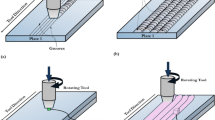Abstract
The mechanical properties of a 7075 aluminium alloy were tested under hydrostatic pressure from atmospheric pressure to 600 MPa. Cylindrical tension specimens, plane strain tension specimens, pre-cracked bend and compact tension specimens were used. The elastic modulus was measured with ultrasonic waves. Several orientations with respect to the rolling direction were investigated. Young's modulus, the elastic limit, and the strain hardening coefficient increased only slightly with pressure. Both tensile and plane strain ductility were greatly enhanced under pressure. The fracture toughness increased with pressure. From the variation of the plane strain ductility the fracture stress of the interface between the void nucleating inclusions and the matrix could be evaluated to be about 3000 MNm-2 in the short transverse direction and 9000 MNm-2 in other directions. The variation of the fracture toughness could be related with the plane strain ductility according to either the model of Broek or the model of Hahn and Rosenfield. Rice's hypothesis relating the critical COD to the mean distance between void nucleating particles could also provide a satisfactory explanation for the enhancement of fracture toughness under pressure.
Résumé
Les propriétés mécaniques d'un alliage d'aluminium AZ5GU ont été mesurées sous pression hydrostatique jusqu'à 600 MPa. Les échantillons utilisés étaient des éprouvettes cylindriques de traction, des éprouvettes de traction en déformation plane, des éprouvettes préfissurées en flexion trois points et en traction. Les modules élastiques ont été mesurés par ultra-sons. Plusieurs orientations, par rapport à la direction de laminage, ont été étudiées. Le module d'Young, la limite d'élasticité, le coefficient d'écrouissage augmentent très peu avec la pression. La ductilité mesurée en traction uniaxiale comme en déformation plane augmentent beaucoup sous pression. La ténacité à la rupture augmente avec la pression. D'après la variation de la ductilité en déformation plane, la contrainte de rupture à l'interface entre les inclusions donnant naissance aux cupules et la matrice, a pu être évaluée à environ 3000 MNm-2 dans le travers court et 9000 MNm-2 dans les autres directions. La direction de la ténacité à la rupture a pu être reliée à la ductilité en déformation plane en suivant soit le modèle de Broek, soit le modèle de Hahn et Rosenfield. L'hypothèse de Rice reliant le déplacement critique à l'extrémité de la fissure à la distance moyenne entre les particules, procure aussi une explication satisfaisante de l'augmentation de la ténacité sous pression.
Similar content being viewed by others
References
H. Ll. D. Pugh, ed., Mechanical Behavior of Materials under Pressure, Elsevier Publ. Co., Amsterdam-London-New York (1970).
J. P. Auger and D. François, Revue de Physique Appliquée, 9 (July 1974) 637.
J.M. Barsom, ASME Transactions, Journal of Engineering, Ind. Series B 93 (1971) 1209.
D. P. Clausing, International Journal of Fracture Mechanics, 6 (1970) 71.
D. Carpentier and M. Contre, Review of Scientific Instruments, 41 (1970) 189.
P. Vigier, Revue de l'Aluminium, 417 (1973) 219.
D. François, J. P. Poirier and Y. Adda, Ann. Phys., 5 (1970) 291–302.
D. Bedere, D. François, C. Jamard and A. Jarlaud, Acta Metallurgica, 19 (Sept. 1971) 973.
S. V. Radcliffe, in Mechanical Behavior of Materials under Pressure, H. Ll. D. Pugh, ed., Elsevier Publ. Co., Amsterdam-London-New York (1970) 638.
A. S. Argon, J. Im and R. Safoglu, in Ductile Fracture, 3rd International Conference on Fracture, Munich (1973).
J. M. Barsom and J. V. Pellegrino, Engineering Fracture Mechanics, 5 (1973) 209.
D. Broek, Engineering Fracture Mechanics, 5 (1973) 55.
G. T. Hahn and A. R. Rosenfield, in “Applications related phenomena in titanium and its alloys,” ASTM Special Technical Publication, 432 (1967) 5.
J. Malkin and A. S. Tetelman, in La Rupture des Métaux, Masson et Co., Paris (1972) 209.
J. R. Rice and M. A. Johnson, in Elastic Behavior of Solids, McGraw-Hill, New York (1970).
D. Aurich, Engineering Fracture Mechanics, 7 (1975) 761.
Author information
Authors and Affiliations
Rights and permissions
About this article
Cite this article
Auger, J.P., François, D. Variation of fracture toughness of a 7075 aluminium alloy with hydrostatic pressure and relationship with tensile ductility. Int J Fract 13, 431–441 (1977). https://doi.org/10.1007/BF00034245
Received:
Issue Date:
DOI: https://doi.org/10.1007/BF00034245




